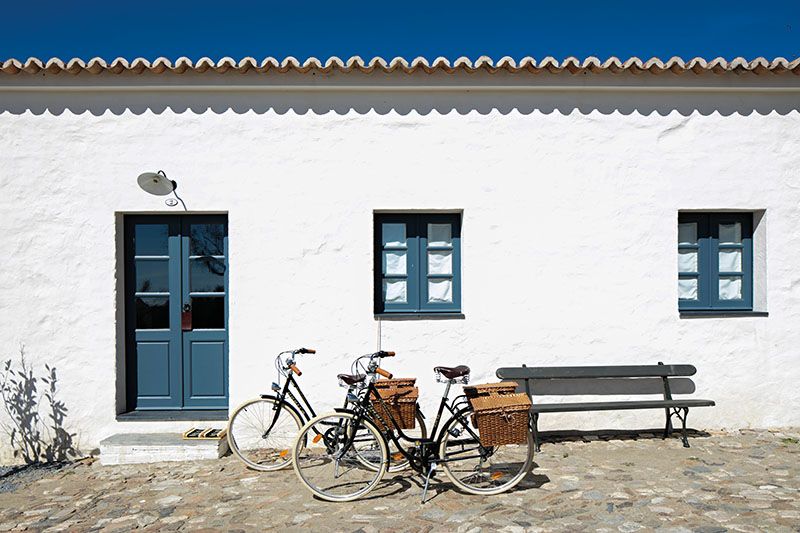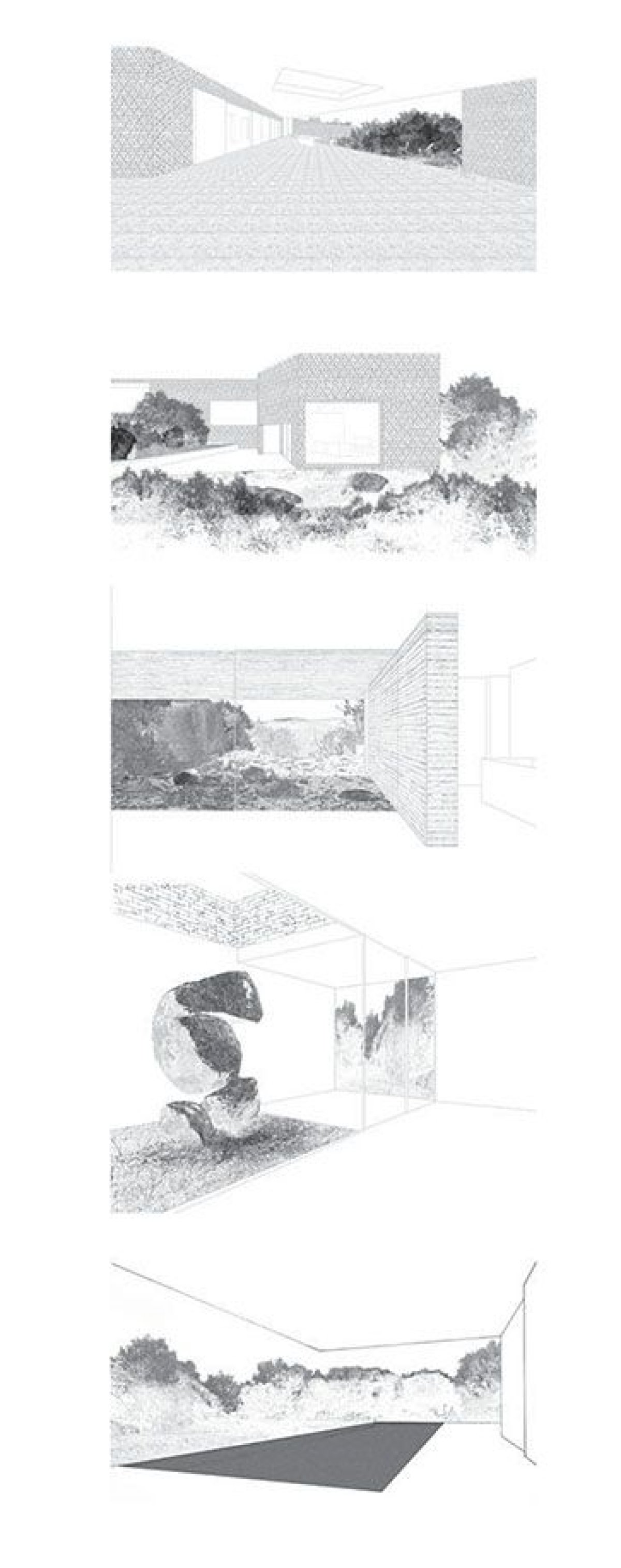
Dawn in the rural wine region of southern Alentejo, Portugal. The sun casts a yolky glow over the cork trees and vineyards of São Lourenço do Barrocal, an estate balanced on Alentejo's western rim. The region makes up a third of Portugal's land mass, but only 3 percent of the population lives here. As a tourist destination, though, it's growing in popularity, and as you make the two-hour drive from Lisbon, you can see why: Whitewashed, medieval towns lie amid rolling hills, olive groves and the forests that make this area the largest producer of cork in the world.
At the entrance to São Lourenço, towering over you like a Neolithic watchman, is an upright granite menhir, the largest of its kind on the Iberian Peninsula. It is one of the numerous prehistoric territorial markers, or barrocais, that give this remote, 1,927-acre farm, hotel and spa its name. And it is the barrocais, some of humanity's earliest experiments with architecture, that have brought two entirely modern architects to São Lourenço.
Pawson and Souto de Moura
First was the Pritzker Prize–winning Portuguese architect Eduardo Souto de Moura. Fascinated by the rich heritage of the site, Souto de Moura has overseen the conversion of a 200-year-old village at the center of the São Lourenço estate into an ascetic yet luxurious agriturismo resort that opened this March. Much of this kind of tourism can be painfully theme-park pastoral. But Souto de Moura's restoration of the village has been so sensitive, so architecturally austere and true to the aesthetics of the region that it integrates better with its landscape than almost anywhere else I have stayed. Agricultural outbuildings have been made into houses, an olive press turned into the bar. The property's 40-year-old developer, José António Uva, whose family has owned the estate for eight generations, was so hell-bent on being true to the materials of the region that he paid a local truck driver to travel around Portugal collecting over 2,000 original roof tiles from agricultural buildings to use for Souto de Moura's conversion—a feat that took two years.
The second big name to be building among the barrocais is John Pawson. The British pioneer of minimalism has, over the years, applied his particularly stern brand of beauty to a Cistercian monastery in the Czech Republic, a Calvin Klein flagship store in New York City and, most recently, the conversion of the old Commonwealth Institute in London into a new home for the Design Museum. His contribution to São Lourenço is, for him at least, a first: designs for two holiday homes on the estate, both of which can be bought off-plan.
This is all part of Uva's plan to revivify both his ancestral home and the wider area. Across the estate, he has marked out 25 plots, ranging between 6,000 to 12,000 square meters, as sites for second homes of significant architectural merit. Two of these come with the Pawson plans attached, two with designs by Souto de Moura, while buyers of the remaining 21 plots can commission their own architects—within strict guidelines. These rules extend to 19 pages, but before building starts designs must be preapproved by Uva (who has the backing of his local planning authority), no home should be visible from any other, and each building is restricted to a single visible story.
Giving buyers a chance to own a spectacular home without having to commission a big-name architect is an advantage of Uva's master plan that Pawson recognizes. "Architecture is a slow business," he tells me over the phone from London. "It involves a huge commitment of time and emotion from both parties. For some people, experiencing the process is essential; for others, there will be a relief that all the big decisions have already been made." Uva has also kept the prices reasonable, especially considering the level of sophistication in the designs: The 25 plots are priced at 300,000 euros ($320,000) each. "Each person is only allowed to build something that is no more than 600 square meters, which is why the plots are priced the same. I personally think all 25 plots are of equal beauty—but of course I'm biased," he says. So far, four plots have gone under offer, with purchasers including a designer from New York City, a Belgian couple and a pair of Portuguese expats. All have bought plots that allow them to choose their own architect. At the time of this writing, the Pawson and Souto de Moura plots are still available.
"When you first meet a potential client, you have a very strong instinctive reaction," Pawson says. "I instantly knew that there was scope to achieve something special architecturally with José." Special or not, he has designed both his properties in his signature style—richly textured, quietly elegant buildings that blend seamlessly into the landscape. Both designs include a library, staff quarters and an outdoor swimming pool, and are deeply informed by how the notional client might live in this rural setting. "With houses, it's about the life that architecture makes possible. Here you want to provide people with a series of gathering places but also allow scope for solitude and retreat. Each of the private quarters has its own secluded space where you can sit out with a book or enjoy the view."

Incorporating the Landscape
He was obliged to work around the barrocais scattered across the estate, but rather than seeing them as obstacles to the designs of his two homes, Pawson embraced them. His first, Plot 12, will be built on a patch of land situated on top of a small hill. The taupe-colored, brick and concrete home will be built over two levels, one semisunken, both connected by a sculptural indoor staircase. Two of the barrocais act as focal points: One will sit beneath an open skylight on the upper, entrance level of the house; the other will be just outside the bedroom window on the lower level. "The stones bring a sense of focus to the vast landscape and will spring up at you at the end of corridors and rooms as an element of surprise," Pawson says. His other house, on Plot 10, will be built atop a spectacular, sloping rock formation; it will have vast windows looking east to the medieval castle and hilltop village of Monsaraz.
The Souto de Moura houses, meanwhile, are typical expressions of his understanding of Mediterranean buildings ("I don't know anyone that knows more about vernacular architecture in Portugal," Uva says.) Souto de Moura's design for Plot 8 overtly references the traditions of local public buildings, using a series of vaulted, domelike spaces to demarcate each individual room, a trick that is museumlike in its grandiosity. His other, more exotic design for Plot 7 is, according to Uva, "a beautiful elevated wooden house on stilts. It sits on a bed of rocks and has a courtyard in the middle with an old olive tree that separates the living area from the sleeping area."
Souto de Moura is a man famously reluctant to speak to the press, but the purchasers of his plots will have the chance to work with him to make sure his houses are built to the right spec. Pawson's drawings are also intended as a starting point. Once clients have bought a plot, they will work closely with him to figure out the logistics, the finishes, and how and whom they want to use to finish the job. This is a very different approach to the usual factory-farm, superluxe holiday resort, where developers get a starchitect to lend his or her name without their being much involved in the designs or their realization. Instead, Uva's attempt to attract cultural tourism to Alentejo offers a rare opportunity to buy into world-class architecture on a domestic scale. And to have a 5,000-year-old stone as your doorman.
For more information about the estate, the hotel and the sites for sale, visit Barrocal.pt.
Uncommon Knowledge
Newsweek is committed to challenging conventional wisdom and finding connections in the search for common ground.
Newsweek is committed to challenging conventional wisdom and finding connections in the search for common ground.
About the writer
To read how Newsweek uses AI as a newsroom tool, Click here.








